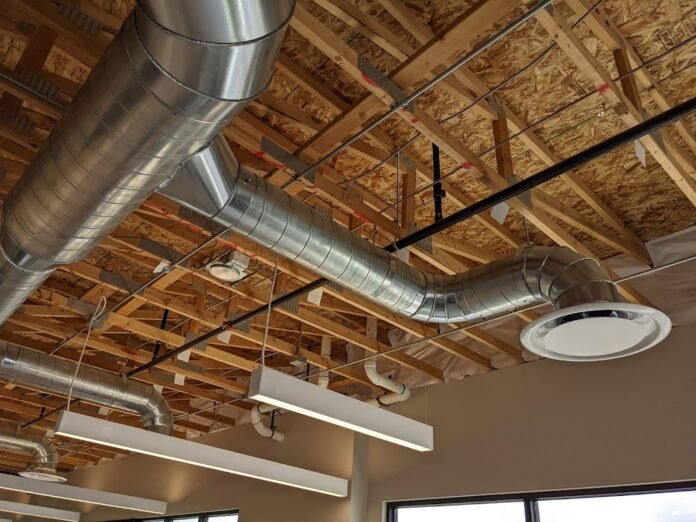HVAC systems have traditionally been seen as functional necessities, hidden behind walls, ceilings, or within utility closets. However, a new wave of design thinking is reimagining heating, ventilation, and air conditioning as integral parts of interior aesthetics.
From exposed ductwork in industrial lofts to custom vents in luxury homes, HVAC elements are increasingly being treated as design features that blend form and function.
The Rise of Visible HVAC in Modern Interiors
Architects and interior designers are no longer hiding HVAC systems with the help of hvac contractors like hvacministries.org. Instead, they are embracing them as part of the overall aesthetic. This approach is especially common in urban design, where minimalism and raw materials reign.
Industrial-Inspired Design Aesthetics
Exposed ductwork, matte black piping, and brushed metal grilles are now signatures of the industrial-chic trend. What once symbolized unfinished construction now conveys deliberate design intent. These finishes complement raw brick, concrete, and open-concept layouts in modern homes and commercial spaces.
High-Design Residential Applications
In high-end residential interiors, HVAC materials are being upgraded to match architectural themes. Custom-designed air vents, decorative grilles, and seamless wall diffusers add visual interest while maintaining airflow. Even thermostats are getting design upgrades with sleek, touchscreen interfaces that blend with minimalist decor.
Commercial Spaces as Style Leaders
Boutique hotels, creative offices, and cafes are also using HVAC finishes to express brand personality. Polished copper ducts, powder-coated metal covers, and reclaimed wood vent surrounds are becoming common. These choices reflect a growing appreciation for cohesive, intentional design across all elements of a space.
Urban Living Meets Functionality
In apartments and condos where space is at a premium, visible HVAC design maximizes utility without compromising aesthetics. Compact duct shapes and modular layouts allow for both efficiency and visual appeal. Designers use clever color schemes and layout planning to integrate these systems beautifully.
Material Choices That Merge Utility with Beauty
As HVAC systems become more visually prominent, the materials used in their construction are evolving too. This shift is driven by both aesthetics and performance.
Metals with Character and Durability
Stainless steel, copper, aluminum, and brass are being chosen not just for durability but for their visual impact. These materials offer a range of finishes from polished to patinated, giving designers flexibility. Their reflective properties also influence light and texture in interior environments.
Wood Accents and Natural Finishes
Wood may seem unconventional for HVAC elements, but it is gaining traction in design-forward homes. Wooden vent covers or enclosures soften mechanical elements and blend with natural interior palettes. They are often custom-made to suit cabinetry, flooring, or ceiling beams.
Painted and Powder-Coated Customization
HVAC grilles, registers, and ductwork can now be painted or powder-coated in any color. Designers are using this option to match hardware, trim, or even wall art. This degree of customization allows HVAC elements to become subtle complements or bold accents.
Sustainable and Recycled Material Options
Eco-conscious designers are exploring reclaimed metals and sustainable wood for HVAC details. These materials support a reduced carbon footprint while contributing to a warm, lived-in aesthetic. They also align with the increasing demand for responsible sourcing in interior design.
The Role of HVAC in Design Narrative
Beyond materials, HVAC systems are beginning to play a more conceptual role in how spaces feel and function. They contribute to the overall narrative of a space just as much as furniture, lighting, or artwork.
Designing for Airflow Aesthetics
Interior designers are considering airflow patterns alongside visual flow. Vents and returns are being placed with intention to enhance both performance and appearance. Linear slot diffusers and flush-mounted vents offer clean lines that support modern and contemporary styles.
Creating Cohesion in Open Spaces
In large, open-plan spaces, visible HVAC lines can create rhythm and structure. Repeated elements like aligned ductwork or symmetrical vent placement add visual order. This approach turns utility into artistry, giving rooms a distinctive edge.
Connecting Comfort with Identity
Climate control is part of how people experience space. Designers are now aligning HVAC choices with brand identity or lifestyle values. Whether it is a wellness spa with diffused aromatherapy air or a tech-forward office with app-controlled climate, the HVAC experience becomes part of the story.
Blending Technology with Design Intent
Smart vents, integrated temperature sensors, and discreet thermostats are becoming central to both comfort and decor. These additions are being chosen not just for their functionality but for how well they blend with room elements. Designers are working closely with HVAC professionals to create harmony between mechanical and visual systems.
Supporting Style with Mission-Driven Service
Hvac organizations are helping ensure that all communities benefit from these evolving design standards. While they focus on essential HVAC service and outreach, their work reminds us that comfort, design, and dignity can coexist. Access to well-designed heating and cooling should be available to every home, not just the architecturally elite.
Conclusion
The role of HVAC in interior design is evolving from hidden utility to celebrated design feature. With thoughtful materials, finishes, and placements, these systems are now contributing to both comfort and aesthetics. Whether it is a polished metal vent in a downtown loft or a handcrafted wood grille in a custom home, HVAC is stepping into the design spotlight and shaping h
